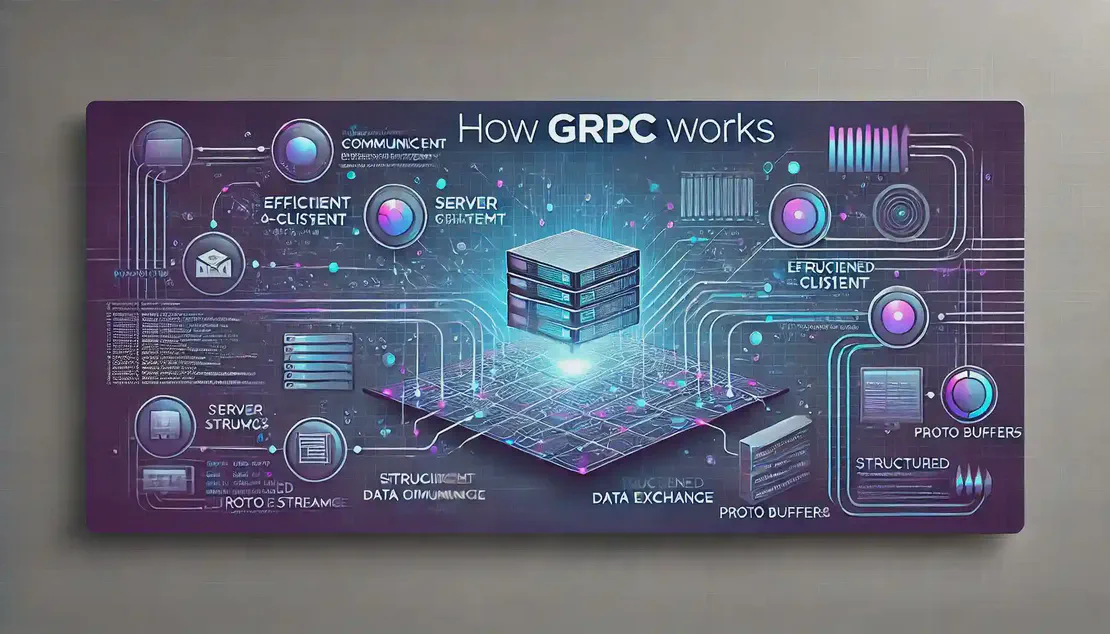Blog Posts
- Home /
- Blog Posts

Introduction to RESTful APIs
🌐 Definition — A RESTful API is an interface that allows two computer systems to exchange information over the internet using the REST architectural style.
Read More
Types of Load Balancing Algorithms
🔄 Load Balancing Algorithm — A load balancing algorithm is a set of predefined rules used by a load balancer to distribute network traffic between servers, ensuring no single server becomes overloaded.
Read More
Protocol Buffers as a Serialization Format
📜 Definition — Protocol Buffers, also known as Protobuf, is a language-neutral, platform-neutral extensible mechanism for serializing structured data, developed by Google.
Read More
How gRPC Works
🔧 Architecture — gRPC is a high-performance, open-source RPC framework that uses HTTP/2 for transport and Protocol Buffers for message serialization. It allows client applications to call methods on a server application as if they were local objects.
Read More
Understanding the Concept of VPNs
🔒 Definition — A VPN, or Virtual Private Network, is a technology that creates a secure and encrypted connection over a less secure network, such as the Internet.
Read More
Canary Deployments: A Safer Way to Roll Out Updates
🐦 Definition — Canary deployment is a strategy where a new software version is released to a small subset of users before a full rollout. This allows for testing in a real-world environment with minimal risk.
Read More
Understanding CI/CD in Software Development
🔄 CI/CD Definition — CI/CD stands for Continuous Integration and Continuous Delivery/Deployment. It is a set of practices that automate the integration of code changes and the delivery of software updates.
Read More
Docker Architecture Explained
🖥️ Client-Server Model — Docker uses a client-server architecture where the Docker client communicates with the Docker daemon to manage containers.
Read More
Kubernetes Architecture Explained
🔧 Control Plane — The control plane manages the overall state of the Kubernetes cluster. It includes components like kube-apiserver, etcd, kube-scheduler, and kube-controller-manager, which handle tasks such as API management, data storage, scheduling, and running controller processes.
Read More
Timeout Pattern in Microservices
⏳ Timeout Pattern — The timeout pattern in microservices is a design strategy used to handle delays and failures in service communication by setting a maximum wait time for responses.
Read MoreCategories
- Microservices ( 27 )
- System-Design ( 16 )
- Scalability ( 10 )
- Rest ( 6 )
- Api ( 6 )
- Distributed-Transaction ( 5 )
- Webdev ( 5 )
- Internet ( 5 )
- Rate-Limiting ( 5 )
- Networking ( 4 )
- Security ( 4 )
- Distributed-Systems ( 4 )
- Network-Protocol ( 3 )
- Devops ( 3 )
- Cicd ( 2 )
- Cloud-Native ( 2 )
- Grpc ( 2 )
- Automation ( 2 )
- Eventual-Consistency ( 2 )
- Databases ( 2 )
- 12-Factor-App ( 1 )
- Ai ( 1 )
- Two-Phase-Commit ( 1 )
- Distributedtracing ( 1 )
- Protobuf ( 1 )
- Domain-Driven-Design ( 1 )
- Paxos ( 1 )
- Service-Discovery ( 1 )
- Cqrs ( 1 )
- Observability ( 1 )
- Performance ( 1 )
- Serialization ( 1 )
- Mqtt ( 1 )
- Software-Architecture ( 1 )
- Concurrency ( 1 )
- Integration ( 1 )
- Vertical-Slice-Architecture ( 1 )
- Timeout-Pattern ( 1 )
- Computing ( 1 )
- Kubernetes ( 1 )
- Retry-Pattern ( 1 )
- Service-Mesh ( 1 )
- Event-Sourcing ( 1 )
- Hinted-Handoff ( 1 )
- Raft ( 1 )
- Generative-Ai ( 1 )
- Software-Best-Practices ( 1 )
- Software-Design ( 1 )
- Privacy ( 1 )
- Backend-Development ( 1 )
- Networrking ( 1 )
- TechExplained ( 1 )
- Conflict-Resolution ( 1 )
- Consensus ( 1 )
- EDA ( 1 )
- Mocroservices ( 1 )
- Database-Sharding ( 1 )
- Headers ( 1 )
- Parallelism ( 1 )
- Architecture-Design ( 1 )
- Architecture-Styles ( 1 )
- Chaos-Engineering ( 1 )
- Circuit-Breaker ( 1 )
- Api-Contracts ( 1 )
- Quorum ( 1 )
- Sidecar-Pattern ( 1 )
- Software-Development ( 1 )
- Technology-Trends ( 1 )
- Vpn ( 1 )
- Applications ( 1 )
- Ddd ( 1 )
- Resilience ( 1 )
- Consistent-Hashing ( 1 )
- Deployments ( 1 )
- Modularity ( 1 )
- Secret-Management ( 1 )
Tags
- System-Design
- Scalability
- Microservices
- Software-Architecture
- Rest
- Api
- Software-Engineering
- Distributed-Transaction
- Internet
- Webdev
- Consistency
- Rate-Limiting
- Api-Security
- Distributed-Systems
- Networking
- Devops
- Security
- Network-Protocol
- Knowledge-Bytes
- Automation
- Cloud-Native
- Databases
- Performance
- Eventual-Consistency
- Database-Sharding
- Cicd
- Grpc
- Paxos
- Raft
- Computing
- Consensus
- Deployments
- Modularity
- Network-Security
- Serialization
- Software-Best-Practices
- Canary-Deployments
- Http
- Kubernetes
- Request-Headers
- Secure-Shell
- Ssh
- 2-Phase-Commit-Pattern
- Database-Partitioning
- Deployment-Strategies
- Httpstatuscodes
- Architecture-Styles
- Ddd
- Vpn
- Ssl
- Consistent-Hashing
- Filtering
- Mqtt
- Tech-Explained
- Cqrs-Pattern
- Event-Sourcing
- Resilience
- Tech-Stack
- Applications
- Artificial-Intelligence
- Conflict-Resolution
- Event-Driven-Architecture
- Partitioning
- Secret-Management
- Software-Development
- 12-Factor-App
- Concurrency
- Observability
- Parallelism
- Timeout-Pattern
- Vertical-Slice-Architecture
- Privacy
- Protobuf
- Technology-Trends
- Microservices-Patterns
- Service-Mesh
- Api-Contracts
- Chaos-Engineering
- Generative-Ai
- Hinted-Handoff
- Integration
- Error-Handling
- Web-Security
- Load-Balancing-Algorithm
- Sidecar-Pattern
- Service-Discovery
- Sharding
- Ai
- Distributedtracing
- Domain-Driven-Design
- Httpmethods
- Encryption
- Pagination
- Response-Headers
- Sorting
- Saga-Pattern
- Software-Design
- Backend-Development
- Quorum